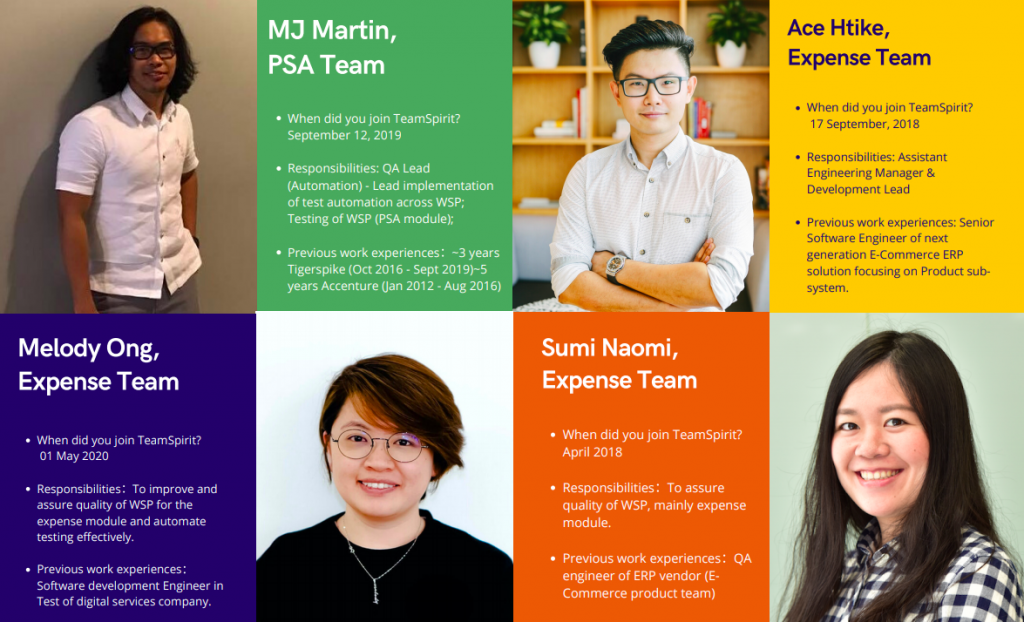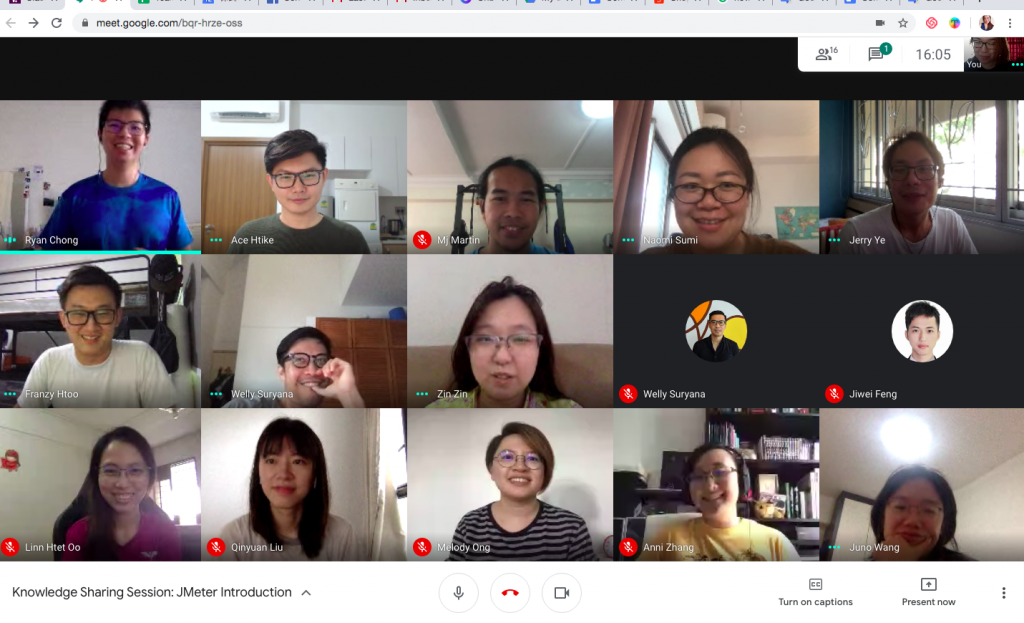Remote Onboarding: Welcoming Melody to TeamSpirit Singapore!
Because of the COVID-19 pandemic situation, many companies are facing unprecedented challenges in the workplace. Against this context, it is important to create a comfortable environment for new hires during the remote onboarding process.
Last week, an online roundtable was held to understand the experience of onboarding our new staff Melody, who joined TeamSpirit Singapore in May ’20. This post is written as a supplement to the ongoing TeamSpirit remote work series (currently in Japanese only).
Introduction of participants

“Overall, how was Melody’s onboarding process?”
Sumi-san: Actually, the preparation to onboard Melody was relatively smooth. This is because I have already met her in Singapore during the interview, and have a rough idea of her personality and vibe.
Also, MJ is the first non-Japanese QA hired by TeamSpirit, so in that sense we already got accustomed to interacting and working with him in spite of possible language barriers.
Because Melody is the second hire in the QA team, MJ is able to empathize and help in case of any possible issues or confusion, because he has gone through the exact onboarding process last year.
MJ: Personally I found the onboarding process smooth, because if there is anything unclear with onboarding, I can always ask Sumi-san or Ace about it.
Also, I think it is important to communicate to Melody that we have a strong teamwork culture at TeamSpirit— that colleagues are here to support her in the event of any difficulties. So we encourage Melody to approach myself, Sumi-san or Go-san in the event of any questions.
Onboarding is always a two-way communication. If a new hire doesn’t ask, there is no way for colleagues to know that you are facing problems in a particular area. On the other hand, we also want to avoid the situation of micromanagement, so it is indeed a thin line to balance.
Ace: In normal onboarding processes, we usually assign someone to sit next to Melody, so that if she seems to be stuck, members can always ask if she is okay, or if she needs help.
However, now that processes are brought online, it is no longer possible to arrange for a buddy to sit next to her to ask if everything is okay, or to observe possible body language.
As MJ mentioned, we would also like to avoid micromanagement. Ever since we started remote work, we have started regular check-ins as well, at least once a day. Even though this is not as much as what we would have done as in the case of communication in office, for example like us popping by each other’s desk casually, it is still something.
Also, in Melody’s situation, because MJ already knew her beforehand, it’ is easy to work together. However, if I were to ask Melody to ask another colleague whom she has never spoken to in the past, it might be a little bit tough for her to talk to the new colleague for the first time.
So I think it is important for other colleagues to do initial and quick proper introductions to break the ice.
“Did you encounter any particular problem?”
Melody: I guess one common problem when it comes to online onboarding is that there is practically no way to tell if Ace, Sumi-san or MJ are busy or not, because I cannot see or read their body languages. So in the physical office context, I imagine that it is possible to get someone else whenever a person seems busy.
However, in this online context, everyone appears busy, so I do my best to be independent, until I’m really stuck at an issue. Then, I’ll have to trouble someone else to solve the issue.
I guess onboarding is always two-way, as MJ mentioned. It is probably nice however, for the new person to realise that she is not alone, that there are always helpful colleagues to approach. 🙂 It also helps that I already know MJ beforehand!
Another difficulty is that I do not have experience in QA testing in expense before, so there are times when I don’t feel like I’m contributing to the team due to a steep learning curve. So sometimes when I see Sumi-san working so hard for testing, I do feel bad and wish fervently that I could contribute more.
Ace: One thing we tried differently for the onboarding process with Melody is to set expectations for three months. Previously, guidance was on a day by day, weekly-on-sprint basis, and we don’t really share our plans for the next three months.
However, this time round we shared the final goal for the first three months. I’m not sure how Melody feels about this– does it make it more stressful?
Melody: Actually, I think it’s good to have three months expectations set, because then mutual expectations are clear…
Wan Wei: Regarding expectations, do you feel the need to over-communicate during online onboarding, just to make sure that your message gets across as intended?
Ace: Sometimes after a long discussion, I try to send a summary so that we can all be on the same page with the meeting discussion. The thing about remote work is that sometimes internet connection might not be stable, and people might be cut off without knowing.
Melody: Yes, one additional thing is that for onboarding, there is usually a lot of new things for the newcomer, so it is actually a bit overwhelming. I feel like the newcomer might not be able to access and remember everything.
It might be useful to consider having some recording sessions, so that we can actually record certain information, instructions and training sessions.

For example, let’s say MJ has a knowledge transfer session. It might be a good idea to record this knowledge transfer session, so that newcomers can actually go back to certain parts of the recording in the event of doubts, instead of having to keep asking MJ for clarifications.
In the event of a lack of recording, for example, the person doing the training might have to do a step-by-step documentation from scratch. Having said that, even documentation might not be clear to a newcomer for he or she might not know where to start.
So in that regard, knowledge sharing via videos might still be the most helpful for the newcomer.
“What is the main difference between online and offline onboarding?”
MJ: I think the the biggest difference between online onboarding and offline onboarding is that we cannot feel the vibe of the newcomer.
Ace: Yes! Especially if we are trying to see if the other person is following what you are saying, or being lost. We also cannot sense the team’s vibes. Even though we do daily standup every morning, we don’t really ask members how they are feeling today.
MJ: For PSA though, we are always open during daily standup. Minato-san is always sharing his feelings with us…
Ace: In general, any team bonding is tough online, as compared to offline. Offline, we usually play pingpong together, so all is good!
Sumi-san: It’s really great that I met Melody in Singapore during the interview, because it was through that that I could have a good sense of her vibes.
Currently, there are also new members joining from the Japan side during COVID-19 remote work period, and because I’ve never met them in real life, it is a bit difficult to sense their vibes, thinking or personalities.
So hopefully we can go back to office soon for once or twice a week to know each other better soon. It’s possible to do onboarding online, but for deeper team bonding perhaps office is the best!
“On a parting note, what are some online onboarding tools you would personally recommend?”
Melody: Personally, I think airtable is a useful tool to get to know new colleagues, especially so because I’ve never met most of them face-to-face prior. The onboarding checklist on airtable is also useful.
I also appreciate the Monday, Wednesday and Friday lunch and teatime sessions to chat informally with the rest of the team– it’s a great initiative and good way to bond.
Having said that I can’t wait to meet everyone in person, hopefully soon.
MJ: I guess one of the tools I’m thankful for is slack, because it really helps with the team’s communications.
Ace: Yea, having said that though, one possible challenge I had when I did my onboarding that Melody might have also faced is perhaps not knowing which Slack channel is for which purposes.
Because the content of some slack channels is entirely in Japanese, sometimes I would translate certain messages, only to realise they are not important. So sometimes Slack gets a bit overwhelming too.
Melody: There is actually one Slack translation chrome extension that gives you real time translation when you hover over it, so that makes life much easier too. The trick here is to use the Slack app web version, so that chrome extension could work.
We wish Melody a fruitful career with TeamSpirit! Is your company onboarding new hires remotely too? We love to hear your feedback and thoughts on remote onboarding– leave a comment and share this post!

